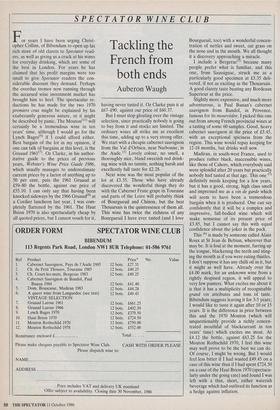SPECTATOR WINE CLUB
Tackling the French from both ends
Auberon Waugh
For years I have been urging Christ- opher Collins, of Bibendum to open up his rich store of old clarets to Spectator read- ers, as well as giving us a crack at his wines for everyday drinking, which are some of the best in London. For years he has claimed that his profit margins were too small to give Spectator readers the con- siderable discount they demand. Perhaps the overdue tremor now running through the accursed wine investment market has brought him to heel. The spectacular re- ductions he has made for the two 1970 premiers crus might be explained by his exuberantly generous nature, or it might be described by panic. The Mouton( El) will certainly be a tremendous wine in ten years' time, although I would go for the Lynch Bages(9) if 1 could afford either. Best bargain of the lot in my opinion, if one can talk of bargains at this level, is the Gruaud 1961(7). Oz Clarke, in his author- itative guide to the prices of previous years, Webster's Wine Price Guide 1986, which usually manages to underestimate current prices by a factor of anything up to 50 per cent, puts the 1961 Gruaud at £59-80 the bottle, against our price of £55.10. I can only say that having been knocked sideways by the 1966 Gruaud(8) at a Cordier luncheon last year, I was com- pletely flattened by the 1961. The Haut Brion 1970 is also spectacularly cheap by all quoted prices, but I cannot vouch for it, having never tasted it. Oz Clarke puts it at £67-£90, against our price of £60.37.
But I must stop gloating over the vintage selection, since practically nobody is going to buy from it and stocks are limited. The ordinary wines all strike me as excellent this time, adding up to a very strong offer. We start with a cheapie cabernet sauvignon from the Val d'Orbieu, near Narbonne, in the Aude.(1) Lovely colour, no smell, a thoroughly nice, bland sweetish red drink- ing wine with no tannin, nothing harsh and excellently full taste for £2.28.
Next wine was the most popular of the lot at £3.35. Those who have already discovered the wonderful things they do with the Cabernet Franc grape in Touraine and parts of the Loire will probably think of Bourgueuil and Chinon, but the best Thouarsais is the quintessence of them all. This wine has twice the richness of any Bourgueuil I have ever tasted (and I love Bourgueuil, too) with a wonderful concen- tration of nettles and sweet, cut grass on the nose and in the mouth. We all thought it a discovery approaching a miracle. I include a Bergerac(3) because many people prefer what is familiar, and this one, from Saussignac, struck me as a particularly good specimen at £3.35 deli- vered, if not as exciting as the Thouarsais. A good clarety taste beating any Bordeaux Superieur at the price.
Slightly more expensive, and much more adventurous, is Paul Bunan's cabernet sauvignon from Bandol, in Provence, famous for its mourvedre. I picked this one out from among French provincial wines at a tasting of some 60 samples. Good, heavy cabernet sauvignon at the price of £3.45, with an exceptional spiciness from the region. This wine would repay keeping for 12-18 months, but drinks well now.
Madiran, in south-west France, used to produce rather black, inaccessible wines, like those of Cahors, which everybody said were splendid after 20 years but practically nobody had tasted at that age. This one (D) definitely needs keeping for a few years, but it has a good, strong, high class smell and impressed me as a yin de garde which will seem to have been a tremendous bargain when it is produced. One can say confidently that it will be a complex and impressive, full-bodied wine which will make nonsense of its present price of £3.85, but I cannot say this with equal confidence about the joker in the pack.
This (6) is made by someone called Main Roux at St Jean de Bebian, wherever that may be. It is foul at the moment, furring up the tongue, blackening the teeth and sting- ing the mouth as if you were eating thistles.
I don't suppose it has any chilli oil in it, but it might as well have. Already over the £4.00 mark, for an unknown wine from a rightly despised region, it will appeal to very few punters. What excites me about it is that it has a multiplicity of recognisable grand yin attributes and tons of taste. Bibendum suggests leaving it for 3-5 years; I would like to taste it again after 10 or 15 years. It is the difference in price between this and the 1970 Mouton (which will unquestionably provide a richly concen- trated mouthful of blackcurrant in ten years' time) which excites me most. At £4.12 the bottle, against £63.25 for the Mouton Rothschild 1970, I feel this wine may well prove to be the best we can do. Of course, I might be wrong. But I would feel less bitter if I had wasted £49.45 on a case of this wine than if I had spent £724.50 on a case of the Haut Brion 1970 (spectacu- larly under the going rate) and found I was left with a thin, short, rather waterish beverage which had outlived its function as a hedge against inflation.


























































 Previous page
Previous page